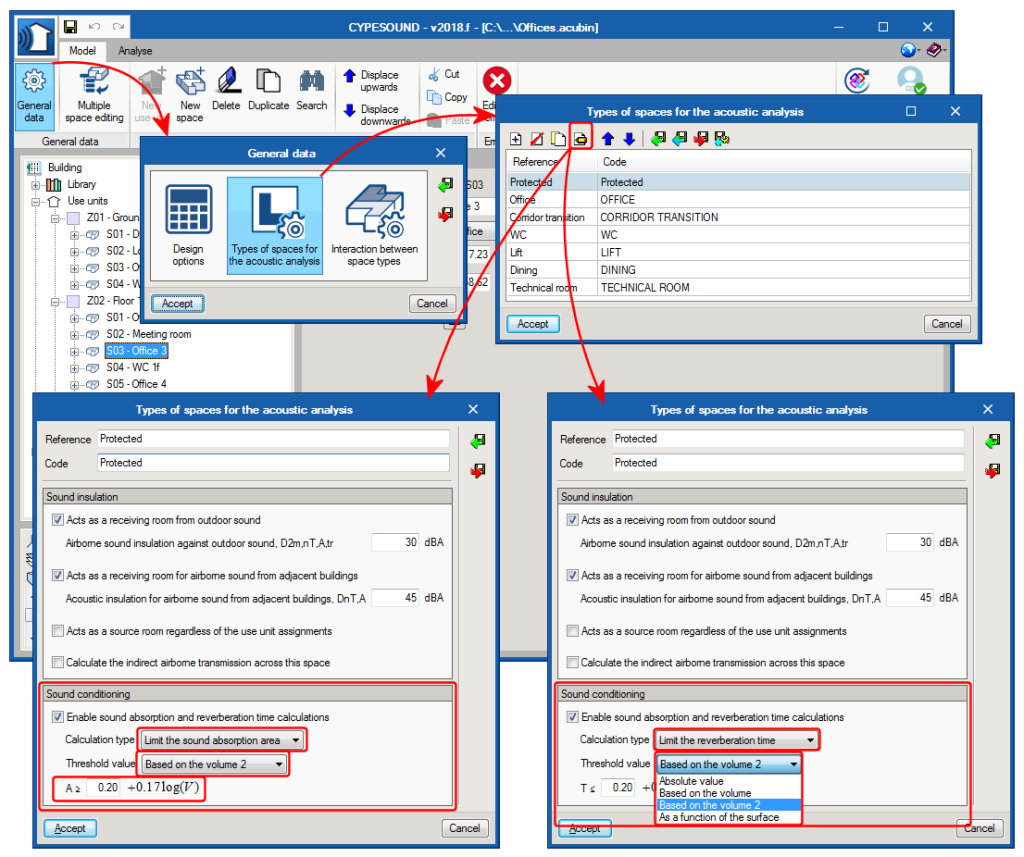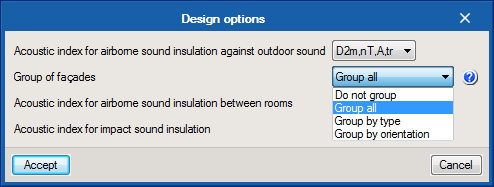As has been implemented in AcoubatBIM by CYPE, as of the 2018.f version of CYPESOUND, users can tell the program to add the spectrum adaptation term C or Ctr (depending on the predominant type of noise) to the acoustic insulation index against outdoor airborne noise.
Update history
CYPESOUND
As of the 2018.f, as has been done in AcoubatBIM by CYPE, a new formula has been added in CYPESOUND to limit the reverberation time and equivalent acoustic absorption area of a space depending on its volume.
The option “Group of façades” has been added to the “Design options” panel of CYPESOUND.
Using this option, users can configure the way in which the outdoor airborne noise insulation is to be verified. As well as the individual analysis of each façade that has been carried out up to now, it is now possible to combine all the façades and check the insulation of the complete envelope of each space. The program also allows for adjacent façades with the same orientation to be grouped and then determines the insulation of these combined elements. Finally, the possibility also exists to group façades depending on their type (façade, roof or overhang), and calculate each group of insulation.
All the information regarding design options and acoustic index limits that are used have been grouped in the “General parameters” panel.
Thanks to this implementation, it is now possible to create diverse acoustic requirements, for example, based on different national codes, and save this information with the aim to use it later in other projects.
As of the 2017.c version, CYPESOUND and its specific versions for some countries, import, from a BIM model, the noise produced by the openings of ventilation systems. Users then had to specify the other properties that specify the noise produced by these openings in a precinct.
As of the 2017.e version, CYPESOUND, CYPESOUND CTE (Spain), CYPESOUND RRAE (Portugal), CYPESOUND NRA (France) and CYPESOUND DRAPDE (Italy), automatically calculate the following parameters: “r” (radius of the largest sphere that can be inscribed in the precinct) and “D” (directivity factor of the source) of the grilles and diffusers. This way, the noise generated by the HVAC duct networks in the precincts can be obtained more easily.
The analysis is carried out during the import process of these elements, based on IFC files, hence the CYPESOUND project must import them from the BIM model (either because the project is linked to a BIM model or, if it is not, because the BIM model has been imported without maintaining the link). Logically, the imported BIM model must include the design of the duct installation for heating, ventilation and air conditioning. CYPETHERM HVAC allows users to export these installations to the BIM model.
Users can import the noise produced by the end elements of the ducts of the HVAC system installed in the building. Thanks to CYPESOUND being an application that is integrated in the Open BIM workflow, this operation can be carried out using IFC information exchange files. To do so, the acoustic parameters must first be exported to IFC using software that also operated with this technology, such as CYPETHERM HVAC, CYPE’s heating, ventilation and air conditioning program.
Once the integration process has been finished, users will have the option to edit the data that has been introduced automatically and indicate the remaining properties that define the noise that is generated by the air conditioning installation.






